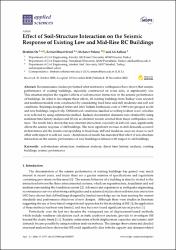Effect of Soil-Structure Interaction on the Seismic Response of Existing Low and Mid-Rise RC Buildings

View/
Access
info:eu-repo/semantics/openAccessAttribution-NoDerivs 3.0 United Stateshttp://creativecommons.org/licenses/by-nd/3.0/us/Date
2020Metadata
Show full item recordCitation
Künye girilecekAbstract
Reconnaissance studies performed after destructive earthquakes have shown that seismic performance of existing buildings, especially constructed on weak soils, is significantly low. This situation implies the negative effects of soil-structure interaction on the seismic performance of buildings. In order to investigate these effects, 40 existing buildings from Turkey were selected and nonlinear models were constructed by considering fixed-base and stiff, moderate and soft soil conditions. Buildings designed before and after Turkish Earthquake code of 1998 were grouped as old and new buildings, respectively. Different soil conditions classified according to shear wave velocities were reflected by using substructure method. Inelastic deformation demands were obtained by using nonlinear time history analysis and 20 real acceleration records selected from major earthquakes were used. The results have shown that soil-structure interaction, especially in soft soil cases, significantly affects the seismic response of old buildings. The most significant increase in drift demands occurred in first stories and the results corresponding to fixed-base, stiff and moderate cases are closer to each other with respect to soft soil cases. Distribution of results has indicated that effect of soil-structure interaction on the seismic performance of new buildings is limited with respect to old buildings.
Source
Applied Sciences-BaselVolume
10Issue
23Collections
The following license files are associated with this item:


















